
LEGO Designer:
Dan Fallon (phreaddee)
Designed:
October 2018
Categories:
Space Stations, All, Space Agency - Roscosmos
Salyut 7 was the last Russian space station before the construction of MIR. It was launched in May 1982, and all up there were 6 principal expeditions, not without it’s own drama. At the end of expedition 3 the craft was left in a state without power and all but abandoned, Soviet Newspapers, in March 1985 wrote “In view of the fact that the planned program of work on Salyut 7 has been fulfilled completely, at the present time the station has been deactivated and is continuing its flight in automatic mode.”
However by the end of March the Soviets resolved to attempt a Salyut 7 rescue. The effort turned out to be one of the most impressive feats of in-space repairs in history. As the Crew of Soyuz T-13 (Vladimir Dzhanibekov, Viktor Savinykh) approached the inert station, they saw that its solar arrays were pointing randomly as it rolled slowly about its long axis. They used a handheld laser range finder to judge their distance, and conducted a fly-around inspection to be certain the exterior was intact. Dzhanibekov noted that the thermal blankets on the transfer compartment had turned a dull gray from prolonged exposure to sunlight.
Upon achieving hard dock—the first time a Soyuz docked with an inactive station—the crew confirmed through the electrical connectors in the docking collars that the Salyut 7 electrical system was dead. They carefully sampled the air in the station before opening the hatch. The station air was very cold, but breathable. Frost covered the walls and apparatus. The cosmonauts wore winter garb, including fur-lined hats, as they entered the station. The first order of business was to restore electric power. Of the eight batteries, all were dead, and two were destroyed. Dzhanibekov determined that a sensor had failed in the solar array pointing system, preventing the batteries from recharging. A telemetry radio problem prevented the TsUP from detecting the problem. Salyut 7 had quickly run down its batteries, shutting down all its systems and accounting for the break in radio contact. The cosmonauts set about recharging the batteries. They used Soyuz-T 13 to turn the station to put its solar arrays in sunlight.
On June 10 they turned on the air heaters. The cosmonauts relied on the Soyuz-T 13 air regeneration system until they could get the Salyut 7 system back in order. On June 13 the attitude control system was successfully reactivated. This was cause for jubilation, as it meant a Progress bearing replacement parts could dock with Salyut 7. Wall heaters were turned on only after all the frost had evaporated, in order to prevent water from entering equipment. Normal atmospheric humidity was achieved only at the end of July. The station’s water tanks thawed by the end of June. Freezing destroyed the water heater, so the cosmonauts used a powerful television light to heat fluids. New solar arrays were installed in August and Vladimir returned to earth, leaving Viktor behind, until the crew of Soyuz T-14 arrived in September.
Now Salyut 7 was operational again, the goal of expedition 5 was the successful retrieval of Kosmos 1686 and to conduct spacewalks and continue with the experiments, however, illness forced the crew to return to earth earlier than expected, after only 65 days. Viktor had been in space for a total of 177 day when he returned in November 1985.
The goal of the final expedition to Salyut 7’s was to retrieve as much as possible from the aging spacecraft and ferry it across to MIR. The crew of Leonid Kizim and Vladimir Solovyov had already experienced a stint on Salyut with expedition 3, and had already spent considerable time aboard the early MIR spacecraft. I chose this particular mission to make this model of, unlike the previous drama filled expeditions for two reasons. the soyuz craft T-15 was the first (and only) craft to make a station to station transfer, and Leonid Kizim, on his return to MIR became the first person to spend more than a year in space. It’s also the last remaining configuration of the craft. Before the crew left for MIR they boosted the altitude of Salyut 7 to 475 miles and it was abandoned, to float in space for another 5 years before crashing and burning up in the atmosphere on reentry in February 1991.
Designer Notes
Downloads
Part count: bricks, lots.
| Unit | width | length | height |
|---|---|---|---|
| Studs | |||
| Inches | |||
| Centimetres |
No external URL provided.
Launch History information from space.skyrocket.de
Launch History information from space.skyrocket.de
Related Posts
None found

